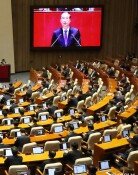Rich Districts Do Not Pay Most for Education
Rich Districts Do Not Pay Most for Education
Posted August. 10, 2007 05:46,
A survey conducted by the Seoul Metropolitan Office of Education found that each district in Seoul spends different amounts of money on education. According to the survey, the richest district offers monetary support eight times as much as the poorest one. The Jung-gu district office spends 157,000 won per person for primary and secondary school education, while Gangbuk-gu spends only 19,000 won per person.
The education office collected the data from the last years education support expense report of 25 district offices. The 25 offices spent 65.479 billion won in total, an average of 45,500 won per student. The most striking point was the big spending gap among districts.
The education expenses are used for different purposes; to improve public education conditions under the approval of the head of district offices; to enhance school meal facilities; to computerize public school education; to offer programs for local residents; and to set up sports and cultural facilities for residents and students.
Jung-gu Topped the List-
Jung-gu gets the largest amount of financial support for education, with 157,800 won per student. Since large businesses, which provide huge corporate taxes, are located in the district, its financial independence rate was 74.3 percent and it supported 4.35 billion won, 2 percent of the total budget, in education expenses last year.
Yongsan-gu was the second with 122,700 won, followed by Seocho-gu with 113,500 won, Mapo-gu with 92,100 won, Gangnam-gu with 67,000 won, Jungrang-gu 62,600 won, Guro-gu with 54,000 won, and Yeongdeungpo-gu with 50,200 won.
Seocho-gu and Gangnam-gu ranked first and second each, with 6.194 billion won and 5.539 billion won, respectively, in terms of total education expenses. Both accounted for 18 percent of the total budget of Seoul City. However, the two districts ranked third and fifth in per capita expenses due to their large number of schools and students.
With the financial support, Jung-gu has completed various facility investment projects, including setting up English classrooms, the modernization of laboratories, and the replacement of blackboards with green boards that are erasable with water. The Jung-gu office also supported 1,328 six-graders from public schools for English Camp programs, and plans to send 26 English native speakers to 24 primary and secondary schools.
Education Satisfaction Affects Elections-
Many districts, though less financially independent, are actively investing in education because education satisfaction affects elections for district legislators.
Jungrang-gus financial independence was 29.27 percent last year, ranking last among 25 districts, but the education share of the total budget was 1.6 percent, or 3.561 billion won, ranking 6th. Guro-gu, whose independence rate is 43.87 percent, ranked 7th with 54,000 won per student.
Jungrang-gu worked with the east district of education office to start a new project by designating a school for high-level English and essay classes. All students in the district are given the opportunities to study English and essays at the school. The head of the Jungrang-gu district office said, Education plays a critical part in resident satisfaction. Despite the difficulties coming from a lack of financial independence, we will increase the amount of financial support for education.
By contrast, Songpa-gu, with an 84.21 percent financial independence rate, spent only 22,100 won per student on education, and Yangcheon-gu, with 59.75 percent, also fell short of offering 24,700 won per student last year.
An official of the Seoul Metropolitan Education Office said, Districts financial independence affects education support, but it is not a critical factor. Rather, the commitment of the head of district offices is more important.
kky@donga.com







